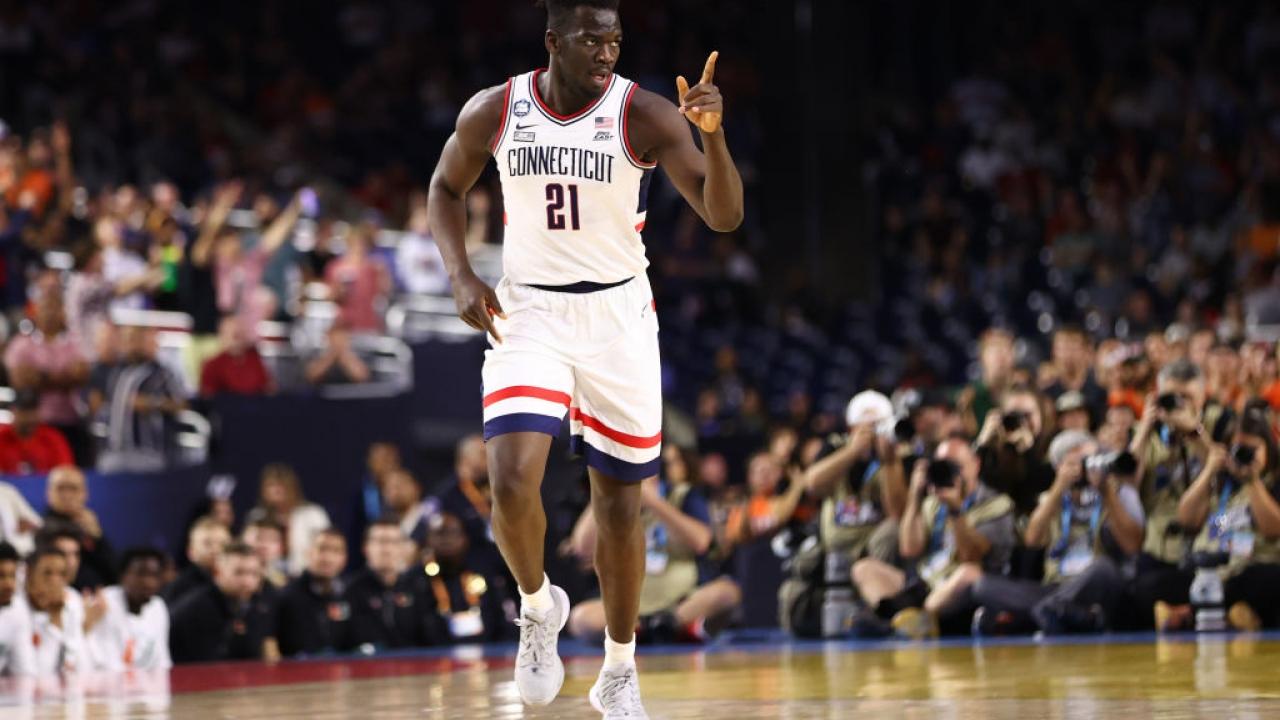Pitt is #62 at 15-7, 8-3 with 3-2 in Q1, 4-4 in Q2. I Examined some above them such as Oregon, VaTech, etc, etc. Doesn't make sense to me. If any of you know why Pitt isn't higher with their credentials, please reply.
Last edited:
Follow along with the video below to see how to install our site as a web app on your home screen.
Note: This feature may not be available in some browsers.


Pitt is #62 at 15-7, 8-3 with 3-2 in Q1, 4-4 in Q2. I Examined some above them such as Oregon, VaTech, etc, etc. Doesn't make sense to me. If any of you know why Pitt isn't higher with their credentials, please reply.
The secrets are kept in a Big 10 vault in the Big 10 headquarters.As others have said, the NCAA has purposely not released the formula (probably to prevent coaches gaming it). The good news is that our NET rank doesn't matter so dont worry about it. My best guess on what I've read is that NET makes a better effort to rank teams based on how good they are, not necessarily your resume. So more of a Vegas-ish predictive model. And to be honest, we really aren't that good of a team. We are winning with hard work, perseverence, toughness, big plays, timely shots, etc.
Yeah somehow they need to find less crappy teams for the nonconference.. Not power 6 and tough teams but teams that won’t crush your nonconference sos. More teams from like 100 to 200. Probably a lot easier said than done!The top quarter of Pitt's OOC schedule was very competitive. The problem is that the other 75% was close to bottom of the barrel. They needed that 25% tough, 50% average and 25% weak mix.
Their OOC is basically all <100 NET opponents and then all >250 NET opponents. No middle. And it's pretty dumb because there probably isn't much of a challenge difference between beating the #140 team at home versus the #240, but it kills your NET.
That's what I was saying, 25% of their OOC schedule was pretty good. The four you mentioned, plus @ Vandy. Literally the rest of the games were against NET dregs. I think UTM was the next highest around 240.Didn’t Pitt play Northwestern, Michigan and VCU in non-conference? Those are all competitive teams. In fact, NW was 15-5 at last look.
Didn’t Pitt play Northwestern, Michigan and VCU in non-conference? Those are all competitive teams. In fact, NW was 15-5 at last look.
They do have two additional ACC games in lieu of OOC. If you count @ncstate and @cuse as pre New Years OOC then not as bad.Yes, the problem is everyone else, as fireball mentioned. Look at this easy graphic reference to see how bad all the other OOC games were:
The top quarter of Pitt's OOC schedule was very competitive. The problem is that the other 75% was close to bottom of the barrel. They needed that 25% tough, 50% average and 25% weak mix.
Their OOC is basically all <100 NET opponents and then all >250 NET opponents. No middle. And it's pretty dumb because there probably isn't much of a challenge difference between beating the #140 team at home versus the #240, but it kills your NET.
Again you are completely wrong. NET rankings DO matter and are the primary tool by the NCAA to determine the field.https://www.ncaa.com/news/basketbal...05/college-basketballs-net-rankings-explainedAs others have said, the NCAA has purposely not released the formula (probably to prevent coaches gaming it). The good news is that our NET rank doesn't matter so dont worry about it. My best guess on what I've read is that NET makes a better effort to rank teams based on how good they are, not necessarily your resume. So more of a Vegas-ish predictive model. And to be honest, we really aren't that good of a team. We are winning with hard work, perseverence, toughness, big plays, timely shots, etc.
Again you are completely wrong. NET rankings DO matter and are the primary tool by the NCAA to determine the field.https://www.ncaa.com/news/basketbal...05/college-basketballs-net-rankings-explained
How are the NET rankings used?
Since the NET rankings serve as the primary sorting tool for Division I men's basketball, they play an important role in establishing a team's resume.
Oh yeah, let me sort through all of the bookmarks I've made of your enlightened posts.See my other post and find the other article I linked. Your own NET is Tier 3 criteria.
Oh yeah, let me sort through all of the bookmarks I've made of your enlightened posts.
But the NET ranking system determines a whole lot more than just your own ranking. It determines the quality of your wins/losses, your perceived strength of schedule, etc.
That's why beating Ohio State at home is considered a Q1 win, even though they've lost 6 out of their 7 away games. It's also why a road win vs 9-12 Ole Miss is a Q2 win, even though they're only 6-6 at home, are a combined 1-10 in Q1 and Q2, and have lost 9 of their last 10 games.
Does NET reward running up the score since its so efficiency based?
I believe so. It uses predictive features so not necessarily running up the score but if Team A and Team B have the same record and same schedule and Team A wins all their games by 20 and Team B wins all their games by 1, Team A would be viewed as the better team. Whereas RPI would have them the same.
Also, I think Pitt's defensive efficiency (110) plays a large role in their NET rank. How bout Jamie at 11 though? BK at 3. Cronin at 6. Lots of old Big East there.
NET doesn’t take scoring margin into account - at least not directly. But if you’re playing really efficiently on offense and defense, you’re probably going to win that game by a huge margin.
It kinda uses it in a round-a-bout way through its efficiency ratings. If you are playing Team B and Team B averages 70 pts and gives up 65 pts, but you beat them 70-65 then you are going to have above average efficiency in both offense and defense. Obviously if you beat them 75-65 then you offensive efficiency is going to be even greater. There is likely a cap on efficiency points given per game so a 20-point win is the same as a 12-point win.It's funny how college football forbid the BCS computers from using margin of victory to discourage running up the score but de facto efficiency ratings in NET encourage it?
It kinda uses it in a round-a-bout way through its efficiency ratings. If you are playing Team B and Team B averages 70 pts and gives up 65 pts, but you beat them 70-65 then you are going to have above average efficiency in both offense and defense. Obviously if you beat them 75-65 then you offensive efficiency is going to be even greater. There is likely a cap on efficiency points given per game so a 20-point win is the same as a 12-point win.
How it all factors and what weights are given is unknown. So beating Team B 65-64 might actually get you a lower efficiency score than losing to them 59-58. It's unlikely, but there probably isn't a big difference between the two scores despite one being a win vs a loss.
To me, the NET is a useful efficiency metric system but also a BS metric system. If anything, take the NET and the RPI and average them out. The NET by itself has poor credibility the way it is.
If you have problems with NET, why on earth would you want to average it out with an even stupider system in the RPI?
I mean even the guy who invented the RPI said that they shouldn't be using it the way that they did, that it was never meant to determine how the teams ranked.
NET doesn’t take scoring margin into account - at least not directly. But if you’re playing really efficiently on offense and defense, you’re probably going to win that game by a huge margin.
Take it one step further. It doesn’t really care if you win or lose.It kinda uses it in a round-a-bout way through its efficiency ratings. If you are playing Team B and Team B averages 70 pts and gives up 65 pts, but you beat them 70-65 then you are going to have above average efficiency in both offense and defense. Obviously if you beat them 75-65 then you offensive efficiency is going to be even greater. There is likely a cap on efficiency points given per game so a 20-point win is the same as a 12-point win.
How it all factors and what weights are given is unknown. So beating Team B 65-64 might actually get you a lower efficiency score than losing to them 59-58. It's unlikely, but there probably isn't a big difference between the two scores despite one being a win vs a loss.
The NET ratings this year are by far the worst and most inconsistent I have ever seen them. The old RPI was far superior to the numbers this year. Virginia Tech higher than others who are more deserving in the ACC is a perfect example why the NET should be scrapped and not be given any credability.
The thing is that VT is a pretty good team. The SMF eye test says they are probably like the 4th or 5th best team in the ACC. I know you wont like this, but they are better than us and really not much worse than Clemson. And the predictive metrics would show that. But this is why your own NET isnt used much. Because it gives a lot of value to "Vegas" metrics that dont take into account games you actually won or lost.
The eye test should be used.
Virginia Tech is 13-4 with Hunter Cattoor in the lineup and he is now back to playing. Tech has wins against Duke, Syracuse, Penn State, North Carolina, Dayton etc. with him in the lineup. Virginia Tech is a completely different team with him.
The eye test should be used discretionarily when seeding teams. And injuries / suspensions absolutely need to be taken into consideration.
The goal of the tournament should be the auto qualifiers plus the best teams left remaining based on multiple efficiency sites plus the eye test.
I dont need an efficiency website for example like NET, torvik, or pomeroy to tell me a team like Ohio State has zero business anywhere near the tournament at this point. And I really dont care the 3 of them all believe Ohio State is a top 30 team when they clearly are not while they sit at the bottom of the big ten.
Wins matter more than anything, including efficiency.
To make things more fair. I believe all the ranking systems have flaws, including Torvik and Pomeroy. The easiest way to remove flaws from one site is to average it out with another site. You could even use poll rankings if you want. I just dont think 1 system like the net should be the be all end all system. Especially when it isnt explained to people the exact way teams are ranked.
Sure hope that they don't have a metric like Pomeroy in front of them given they have teams like 10-13 Washington State from the PAC12, who I think is rated right around the ACC and Sam Houston State, whose in 5th place in the WAC, ahead of Pitt.You know that the team sheets that the committee uses have more metrics on them than just the NET, right? There isn't any need to average together the NET and Pomeroy and Sagarin or whatever, because they have those ratings right there in front of them.
In fact the team sheets have six different metrics on them. Three of them are "efficiency" metrics, two of them are results oriented metrics, and then the NET rating, which was originally a bastardization of the two but which seems to now be more of an efficiency metric than a results metric.
Sure hope that they don't have a metric like Pomeroy in front of them given they have teams like 10-13 Washington State from the PAC12, who I think is rated right around the ACC and Sam Houston State, whose in 5th place in the WAC, ahead of Pitt.
Hard to make much sense out of these computer ratings, but like you said, efficiency over outcomes, I suppose...


